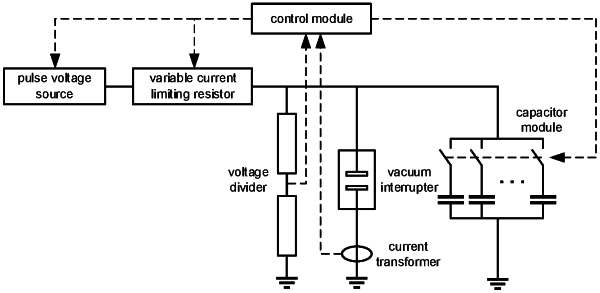| CPC H01H 33/59 (2013.01) [H03K 5/24 (2013.01)] | 5 Claims |

|
1. A pulse voltage conditioning method of a vacuum interrupter with automatic conditioning energy adjustment, comprising steps of: decreasing a voltage if breakdown occurs and increasing the voltage if the breakdown does not occur, so as to adjust a conditioning energy based on a trend of a breakdown voltage of the vacuum interrupter during a conditioning process; automatically adjusting a current-limiting resistor and a parallel capacitor to optimize the conditioning energy, thereby removing insulation defects on electrode surfaces and improving insulation performance of a vacuum gap;
wherein the pulse voltage conditioning method comprises specific steps of:
step 1: according to a voltage level of the vacuum interrupter, determining a peak value of a conditioning initial pulse voltage Uc(0), which is P1 times of a breakdown voltage UL under a standard lightning impulse voltage of the vacuum interrupter at the voltage level, wherein P1 ranges from 20%-50%;
Uc(0)=P1·UL (1)
step 2: according to the conditioning initial pulse voltage, adjusting an initial conditioning energy to Qc(0), wherein Qc(0) ranges from 1-10 J; if an output energy of a pulse voltage source is larger than Qc(0), then connecting the current-limiting resistor in series to an output end of the pulse voltage source to decrease the conditioning energy; if the output energy is less than Qc(0), connecting the parallel capacitor to both ends of the vacuum interrupter to increase the conditioning energy;
step 3: successively applying a pulse voltage to the vacuum interrupter, measuring a breakdown voltage of the vacuum interrupter with a voltage divider, and measuring a breakdown current Ib(n) flowing through the vacuum interrupter with a current transformer; wherein if a peak value of a current flowing through the vacuum interrupter exceeds a critical value of a breakdown current Ibc, the vacuum interrupter is judged to break down, otherwise the vacuum interrupter withstands the pulse voltage; Ibc ranges from 10-20 mA;
Ib(n)≥Ibc (2)
if the vacuum interrupter breaks down, decreasing an applied pulse voltage in a next conditioning process by ΔU:
Uc(n+1)=Uc(n)−ΔU (3)
wherein a voltage step ΔU is P2 times of the breakdown voltage UL under the standard lightning impulse voltage of the vacuum interrupter at the voltage level, and P2 ranges from 1%-4%;
ΔU=P2·UL (4)
if the vacuum interrupter withstands the pulse voltage, increasing the applied pulse voltage in the next conditioning process by ΔU:
Uc(n+1)=Uc(n)+ΔU (5)
step 4: counting a trend of the breakdown voltage and a maximum breakdown voltage Ubmax during the conditioning process, and calculating the conditioning energy Qc(n) according to waveforms of a measured breakdown voltage Ub(n) and the breakdown current Ib(n):
Qc(n)=∫(Ub(n)·Ib(n)dt (6)
wherein if the breakdown voltage decreases to P3 times of the maximum breakdown voltage Ubmax, a deconditioning effect is judged to occur, and P3 ranges from 70%-90%;
Uc≤P3·Ucmax (7)
then increasing the current-limiting resistor or decreasing the parallel capacitor to decrease a next conditioning energy Qc(n+1) to P4 times of Qc(n), wherein P4 ranges from 80%-90%; meanwhile, counting the trend of breakdown voltage and the maximum breakdown voltage Ubmax again;
Qc(n+1)P4#Qc(n) (8)
step 5: if the deconditioning effect never occurs since beginning of the conditioning process, defining the conditioning energy as being low, and decreasing the current-limiting resistor or increasing the parallel capacitor to increase the next conditioning energy Qc(n+1) to P5 times of Qc(n), wherein P5 ranges from 105%-120%; if the deconditioning effect occurs, stopping increasing the conditioning energy, so as to gradually adjust the conditioning energy to a critical value where the deconditioning effect does not occur; wherein the critical value is a maximum conditioning energy without damaging the electrode surfaces, which is an optimal conditioning energy;
Qc(n+1)P5·Qc(n) (9) and
step 6: if the maximum breakdown voltage Ubmax of the vacuum interrupter does not increase in continuous Ns conditioning experiments during which the deconditioning effect does not occur, regarding insulation performance of the vacuum interrupter as optimal and ending the conditioning process, wherein Ns ranges from 300-500.
|